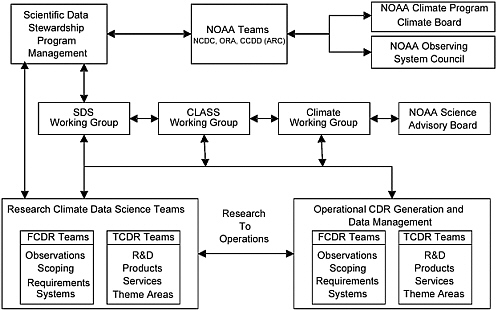SCIENTIFIC DATA STEWARDSHIP ORGANIZATIONAL ELEMENTS
In the committee’s first report, organizational elements that are critical to successful CDR generation programs were identified (see Box 1). These organizational elements are standard processes and policies that lead to actions and improvements in CDR generation programs. They include mechanisms for providing scientific oversight and advice, encouraging feedback from user communities, and allowing opportunities to redirect the program based on advice and feedback. The committee recommended that a leadership council of NOAA management personnel be established to adopt responsibility for overall stewardship of the CDR program. In order to ensure participation of the broader community, this leadership council should be guided by an advisory council composed mainly of external members. The members should be from academia, the private sector, and other federal agencies, as well as some representatives from NOAA. Finally, teams of experts from the broad community, not just experts from NOAA, should be appointed to guide the creation and generation of both FCDRs and TCDRs.
The SDS Implementation Plan describes many different existing and proposed groups that would undertake these responsibilities. The following are examples of these various advisory committees, boards, and working groups:
-
NOAA Data Stewardship Committee (formerly the National Environmental Satellite, Data, and Information Service [NESDIS] Data Archive Board)
-
Archive Requirements Working Group under the Data Archive Board (a defunct NESDIS line office)
-
NOAA Observing System Council
-
NOAA Climate Board
-
FCDR Teams
-
TCDR Teams
-
NOAA Science Advisory Board
-
SDS Working Group
-
Climate Working Group
-
CLASS Working Group
The committee is pleased to see that NOAA takes seriously the need for input and oversight in the generation of CDRs. However, aside from the FCDR and TCDR teams (NOAA, 2005, p. 45), the functions and membership of each of these groups are not presented clearly in the plan. Also, it is not clear what the role of external communities will be in providing input and oversight to the generation of CDRs and in reviewing the accessibility and distribution of CDRs to the user community. In particular, the draft NOAA implementation plan does not provide clear mechanisms for engaging the broader academic community, private sector, or other federal agencies in the development and continuing stewardship of satellite CDRs. The revised plan should present clear definitions of the multiple advisory groups providing oversight for CDR generation, their roles and responsibilities, their makeup, and mechanisms for selecting members.
While the highest-level advisory groups such as the NOAA Science Advisory Board and the Climate Working Group already exist, other entities have to be created. In particular, the council to advise and oversee scientific components of implementing the FCDR and TCDR teams, as proposed in the committee’s first report (NRC, 2004, p. 46), does not yet exist. The SDS Implementation Plan indicates that NOAA intends to establish such a group, called the SDS-CLASS Working Group (see Figure 4.3 in NOAA, 2005) to provide oversight of both the SDS and CLASS efforts. The committee believes that the objectives of CLASS and SDS are sufficiently distinct to require different types of expertise to advise on program implementation, thus warranting two separate advisory groups. Indeed an advisory council focused on the scientific dimension (i.e., the purview of SDS)
rather than on computing requirements (i.e., the purview of CLASS) is consistent with the recommendations of the committee’s first report. Of course, the separate SDS and CLASS working groups should be closely coordinated. The committee recommends separating the working groups for SDS and CLASS, which have to be well coordinated but should function separately to advise their respective activities.
Figure 1 of this report is a revised version of the Figure 4.3 from the SDS Implementation Plan and illustrates how the committee envisions the separate SDS and CLASS working groups fitting into the advising structure. The SDS Working Group provides external advice and input to the FCDR and TCDR teams, while these teams also exchange direct guidance and input with the NOAA managers of the SDS program, who in turn report up through NOAA management to both the climate and the observing system leadership. Through its interaction with the CLASS Working Group, the SDS Working Group provides input to CLASS operations and CDR generation. Because the SDS Working Group will have to coordinate with multiple other advisory groups, it will be necessary to develop mechanisms, such as overlapping membership, to facilitate these interactions.

Figure 1 Revised chart showing SDS organizational elements. NOTE: NCDC = National Climatic Data Center, ORA = NOAA Satellites and Information Service Office of Research and Applications, CCDD (ARC) = NOAA’s Climate Change Data and Detection program element and its Applied Research Center initiative.


